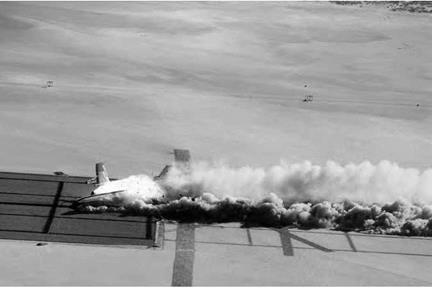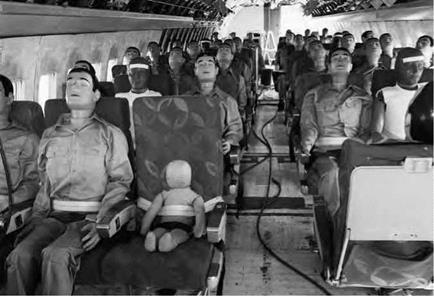Full-Scale Transport Controlled Impact Demonstration
This dramatic and elaborate crash test program of the early 1980s was one of the most ambitious and well-publicized experiments that NASA has conducted in its decades-long quest for increased aviation safety. In this 1980-1984 study, the NASA Dryden and Langley Research Centers joined with the FAA to quantitatively assess airline crashes. To do this, they set out to intentionally crash a remotely controlled Boeing 720 airliner into the ground. The objective was not simply to crash the airliner, but rather to achieve an "impact-survivable” crash, in which many passengers might be expected to survive.[369] This type of crash would allow a more meaningful evaluation of both the existing and experimental cabin safety features that were being observed. Much of the information used to determine just what was "impact-survivable” came from Boeing 707 fuselage drop tests conducted previously at Dryden’s Impact Dynamics Research Facility and a similar but complete aircraft drop conducted by the FAA.[370]
The FAA’s primary interest in the Controlled Impact Demonstration (CID, also sometimes jokingly referred to as "Crash in the Desert”) was to test an anti-misting kerosene (AMK) fuel additive called FM-9. This high – molecular-weight polymer, when combined with Jet-A fuel, had shown promise during simulated impact tests in inhibiting the spontaneous combustion of fuel spilling from ruptured fuel tanks. The possible benefits of this test were highly significant: if the fireball that usually follows an aircraft crash could be eliminated or diminished, countless lives might be saved. The FAA was also interested, secondarily, in testing new safety-related design features. NASA’s main interest in this study, on the other hand, was to measure airframe structural loads and collect crash dynamics data.[371]
|
A remotely controlled Boeing 720 airliner explodes in flame on December 1, 1984, during the Controlled Impact Demonstration. Although the test sank hopes for a new anti-misting kerosene fuel, other information from the test helped increase airline safety. NASA. |
With these objectives in mind, researchers from the two agencies filled the seats of the "doomed” passenger jet with anthropomorphic dummies instrumented to measure the transmission of impact loads. They also fitted the airliner with additional crash-survivability testing equipment, such as burn-resistant windows, fireproof cabin materials, experimental seat designs, flight data recorders, and galley and stowage-bin attachments.[372]
The series of tests included 15 remote-controlled flights, the first 14 of which included safety pilots onboard. The final flight took place on the morning of December 1, 1984. It started at Edwards AFB, NV, and ended with the intentional crash of the four-engine jet airliner onto the bed of Rogers Dry Lake. The designated target was a set of eight steel posts, or cutters, cemented into the lakebed to ensure that the jet’s fuel tanks ruptured. During this flight, NASA Dryden’s Remotely Controlled Vehicle Facility research pilot, Fitzhugh Fulton, controlled the aircraft from the ground.[373]
The crash was accomplished more or less as planned. As expected, the fuel tanks, containing 76,000 pounds of the anti-misting kerosene jet fuel, were successfully ruptured; unfortunately, the unexpectedly
|
Instrumented test dummies installed in Boeing 720 airliner for the Controlled Impact Demonstration of December 1, 1984. NASA. |
spectacular fireball that ensued—and that took an hour to extinguish— was a major disappointment to the FAA. Because of the dramatic failure of the anti-misting fuel, the FAA was forced to curtail its plan to require the use of this additive in airliners.[374]
In most other ways, however, the CID was a success. Of utmost importance were the lessons learned about crash survivability. New safety initiatives had been tested under realistic conditions, and the effects of a catastrophic crash on simulated humans were filmed inside the aircraft by multiple cameras and later visualized at the crash site. Analysis of these data showed, among many other things, that in a burning airliner, seat cushions with fire-blocking layers were indeed superior to conventional cushions. This finding resulted in FAA-mandated flammability standards requiring these safer seat cushions.[375] Another important safety finding that the crash-test data revealed was that the airliner’s adhesive-fastened tritium aisle lights, which would be of utmost importance during postcrash emergency egress, became dislodged and
nonfunctional during the crash. As a result, the FAA mandated that these lights be mechanically fastened, to maximize their time of usefulness after a crash.[376] These and other lessons from this unique research project have made commercial travel safer.












